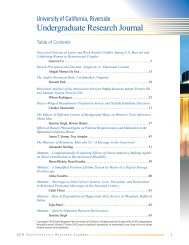2010 - Undergraduate Research, Scholarship and Creative Activity
2010 - Undergraduate Research, Scholarship and Creative Activity
2010 - Undergraduate Research, Scholarship and Creative Activity
Create successful ePaper yourself
Turn your PDF publications into a flip-book with our unique Google optimized e-Paper software.
aspect of the process involves developing<br />
synthesis conditions for ZnO <strong>and</strong> the in-situ<br />
monitoring (via atomic force microscopy) of<br />
ZnO synthesized on a Au wafer (1) at low<br />
temperatures <strong>and</strong> under neutral solution<br />
conditions. The second aspect involves synthesizing<br />
ZnO (1) in the presence of amino acids<br />
with different ―R‖ groups (hydrophilic,<br />
hydrophobic, acidic <strong>and</strong> basic), (2) at low<br />
temperatures, <strong>and</strong> (3) a range of pH‘s in order to<br />
exert kinetic control of the crystal growth<br />
process. Initial results show that L-Histidine <strong>and</strong><br />
L-Cysteine have significant effects on crystal<br />
morphology <strong>and</strong> are subsequently studied. This<br />
research will help us further utilize the mineralspecific<br />
interactions that occur in nature so that<br />
we can synthesize advanced functional materials<br />
in a more cost efficient <strong>and</strong> environmentally<br />
friendly way.<br />
Using in vivo <strong>and</strong> in vitro models to identify<br />
the consequences of manipulating chemokine<br />
<strong>and</strong> immune response genes during CNS<br />
neuroinflammation<br />
Tokunbo Ayeni, Biology<br />
Amelia Lipscomb, Neuroscience<br />
Contributors: Joe Elsissy, Angie Garcia<br />
Mentor: Monica J. Carson<br />
Division of Biomedical Sciences<br />
Interactions between the central nervous system<br />
(CNS) <strong>and</strong> the immune system are essential to<br />
maintain optimal brain function during health<br />
<strong>and</strong> after injury or infection by pathogens.<br />
Chronic <strong>and</strong>/or dysregulated interactions<br />
between the CNS are hypothesized to contribute<br />
to the onset <strong>and</strong> progression of multiple<br />
neurologic disorders including Alzheimer‘s<br />
disease. In our lab, we are focusing on the role<br />
of two molecules: 1) CCL21, a chemoattractant<br />
molecule that recruits <strong>and</strong> retains T cells <strong>and</strong><br />
dendritic cells in the CNS, <strong>and</strong> 2) Tmem176b, a<br />
tetraspan membrane protein that is expressed by<br />
macrophages in the CNS during acute neuroinflammatory<br />
conditions that successfully<br />
resolve. Our hypothesis is that failure to express<br />
sufficient Tmem176b may contribute to the<br />
transition of beneficial acute inflammation to<br />
detrimental chronic inflammation. We can test<br />
whether Tmem176b expression is correlative or<br />
causative in the resolution of neuroinflammation<br />
by testing in vitro if Tmem176b alters<br />
macrophage activation <strong>and</strong> by testing in vivo. In<br />
vitro, we have cultured two types of macrophage<br />
cell lines. RAW cells which are immortalized<br />
peripheral macrophage cells <strong>and</strong> BV-2 cells<br />
which are immortalized microglia. Microglia<br />
are a type of macrophage that is specific to the<br />
CNS. We have prepared maxipreps of<br />
Tmem176b expression plasmids that when transfected<br />
into RAW <strong>and</strong> BV-2 cells results in the<br />
over expression of Tmem176b. Because the<br />
plasmid also contains the reporter molecule,<br />
green-fluorescent protein (GFP), we can detect<br />
the cells which were successfully transfected.<br />
Using this tools, we have discovered that overexpression<br />
of Tmemb176b promotes apoptosis<br />
of both macrophage <strong>and</strong> microglia-like cells. We<br />
can also test the function of Tmem176b in vivo<br />
by overexpressing Tmem176b in mouse models<br />
where we selectively promote inflammation by<br />
transgenically manipulating expression of<br />
CCL21. For this purpose we are breeding <strong>and</strong><br />
genotyping four types of mice: a) wild-type<br />
expression of CCL21 throughout the body, b)<br />
lack expression of CCL21 (plt/plt CCL21<br />
knock-out mice), c) selective expression in the<br />
pancreas (Ins-CCL21 transgenic mice), <strong>and</strong> d)<br />
selective expression in the brain (GFAP-CCL21<br />
transgenic). As part of this portion of our<br />
studies, we have learned to use PCR based<br />
methodologies to determine the presence or<br />
absence of specific endogenous genes (CCL21)<br />
or transgenes (Ins-CCL21 <strong>and</strong> GFAP-CCL21).<br />
Issues of Drinking Water Quality in India<br />
Jennifer Barr, Anthropology/<strong>Creative</strong> Writing<br />
Mentors: Sally Ness, Department of<br />
Anthropology<br />
David Cwiertny, Department of Environmental<br />
Engineering<br />
Around 37.7 million Indians are afflicted with<br />
waterborne diseases each year. Thirty percent<br />
(30%) of urban households <strong>and</strong> 90% of rural<br />
households in India rely entirely on untreated<br />
drinking water, depending on surface <strong>and</strong><br />
ground water sources contaminated by the<br />
results of poor sanitation <strong>and</strong> waste disposal.<br />
Poor water quality has had far-reaching<br />
Fourth Annual UCR Symposium for <strong>Undergraduate</strong> <strong>Research</strong>, <strong>Scholarship</strong> <strong>and</strong> <strong>Creative</strong> <strong>Activity</strong><br />
20














